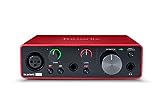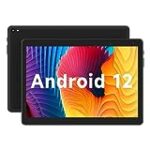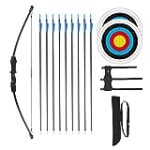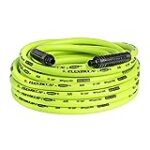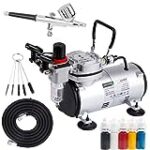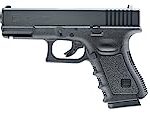🌅 Introduction
Welcome to our comprehensive audio interfaces buying guide! Whether you’re a professional musician, podcaster, or simply a passionate music enthusiast, finding the perfect audio interface is crucial for capturing high-quality sound. In this guide, we’ll walk you through everything you need to know about audio interfaces, from their importance in recording and producing music to the key factors to consider before making a purchase. With our expert recommendations and insider tips, you’ll be equipped to make an informed decision and take your audio production to the next level. Let’s dive in!
🏆 Our Top 5
- Pro performance with great pre-amps - Achieve a brighter recording thanks to the high performing mic pre-amps of the Scarlett 3rd Gen. A switchable Air mode will add extra clarity to your acoustic instruments when recording with your Solo 3rd Gen.
- Get the perfect guitar and vocal take with - With two high-headroom instrument inputs to plug in your guitar or bass so that they shine through. Capture your voice and instruments without any unwanted clipping or distortion thanks to our Gain Halos.
- Studio quality recording for your music & podcasts - Achieve pro sounding recordings with Scarlett 3rd Gen’s high-performance converters enabling you to record and mix at up to 24-bit/192kHz. Your recordings will retain all of their sonic qualities.
- Low-noise for crystal clear listening - 2 low-noise balanced outputs provide clean audio playback with 3rd Gen. Hear all the nuances of your tracks or music from Spotify, Apple & Amazon Music. Plug-in headphones for private listening in high-fidelity.
- Easy Start - It’s easier than ever to get up and running with your Scarlett 3rd Gen with our online tool, Easy Start. Whether you’re looking to record or playback audio, we will help you get started.
- Podcast, Record, Live Stream, This Portable Audio Interface Covers it All – USB sound card for Mac or PC delivers 48 kHz audio resolution for pristine recording every time
- Be ready for anything with this versatile M-Audio interface - Record guitar, vocals or line input signals with one combo XLR / Line Input with phantom power and one Line / Instrument input
- Everything you Demand from an Audio Interface for Fuss-Free Monitoring – 1/8” headphone output and stereo RCA outputs for total monitoring flexibility; USB/Direct switch for zero latency monitoring
- Get the best out of your Microphones - M-Track Solo’s transparent Crystal Preamp guarantees optimal sound from all your microphones including condenser mics
- The MPC Production Experience - Includes MPC Beats Software complete with the essential production tools from Akai Professional
- Value-packed 2-channel USB 2.0 interface for personal and portable recording.
- 2 high-quality Class-A mic preamps make it easy to get a great sound.
- 2 high-headroom instrument inputs to record guitar, bass, and your favorite line-level devices, plus MIDI I/O.
- Studio-grade converters allow for up to 24-bit/96 kHz recording and playback.
- Comes with over $1000 worth of recording software including Studio One Artist, Ableton Live Lite, and Studio Magic Plug-In suite.
- 2-channel USB Audio Interface with 1 XENYX Preamp
- Instrument Input
- Phantom Power
- 48kHz
- 【Clear Studio Quality & Real Time Monitoring】Get professional sound recordings with high-performance USB audio interface which enable you to record and mix at up to 24-bit/192kHz. Your recordings will retain all of their sonic qualities so that you can hear all the details in your track on playback. Meanwhile the headphone jack enables zero-latency, low-noise monitoring.
- 【Audio Interface 2 In and 2 Out】The USB audio interface features 2 XLR/Line combo input for Guitar and Microphone. Its powerful preamp can provide a maximum of 60dB of input gain. The audio interface also includes a HI-Z selection switch, suitable for high-impedance instruments or mic inputs. Equipped with 2 balanced TRS main line-level outputs for speakers and a stereo headphone output with independent level control, it's for learning podcasting or recording audio.
- 【48V Phantom Power for Microphone】The USB audio interface supports 48V phantom power, making it suitable for condenser microphones commonly used in recording and podcasting. The phantom light indicates if the phantom power is on. It is suitable for podcasting and video recording on PC and Mac.
- 【Beginners User-Friendly】 Designed with novice users in mind, the interfaz de audio mixer for studio is plug and play. Forget about complicated installations and driver hassles, just ready to work as soon as you connect the interface with your guitar, Mac or PC. Don't need to be a tech expert to start creating amazing audio. (Please turn the "Power Source" key to "ON", after connecting the power supply, ).
- 【Compatible with Recording Softwares】The usb guitar interface is compatible with Mac/Win 7 or above computer operating systems, NO NEED to DOWNLOAD ANY DRIVERS. Whether for a podcast on the road, a singing practice session outdoors, or a voice-over job. Portable guitar interface your reliable companion for all your audio needs, in any setting - home, studio, meeting room or live streaming.
🤔 How to choose?
1. Compatibility: Ensuring Seamless Integration
When choosing an audio interface, it is crucial to consider its compatibility with your existing setup. Whether you are a musician, podcaster, or content creator, you need an interface that seamlessly integrates with your computer, software, and other equipment.
For example, if you are a Mac user, you might want to consider interfaces that are specifically designed for macOS, such as the Apogee Duet or Universal Audio Apollo Twin. On the other hand, if you are a Windows user, you should look for interfaces that have robust driver support for your operating system.
2. Connectivity: Meeting Your Needs
The connectivity options offered by an audio interface are another important factor to consider. Different interfaces come with various input and output options, such as XLR, TRS, MIDI, and USB.
If you are a singer-songwriter who primarily records vocals and acoustic instruments, an interface with a couple of XLR inputs and a headphone output might be sufficient. However, if you are a producer who works with multiple synthesizers, drum machines, and outboard gear, you might need an interface with a greater number of inputs and outputs, as well as MIDI connectivity.
3. Audio Quality: Capturing Every Nuance
The audio quality of an interface is paramount, as it directly affects the fidelity of your recordings. Look for interfaces that offer high-resolution audio, low noise floor, and transparent preamps.
As renowned audio engineer Sylvia Massy once said, “The audio interface is the first link in the chain of capturing sound, so it’s important to have a good one.” A high-quality interface will ensure that every nuance of your performance is accurately captured, allowing you to achieve professional-sounding recordings.
4. Portability: On-the-Go Recording
If you often find yourself recording outside of your studio, portability becomes a crucial consideration. Portable audio interfaces are designed to be lightweight and compact, allowing you to take your recording setup wherever you go.
For example, the Focusrite Scarlett series offers a range of portable interfaces that are perfect for musicians who frequently record on location or travel for gigs. These interfaces provide excellent audio quality without compromising on portability.
5. Budget: Finding the Right Balance
While it is tempting to go for the most expensive audio interface on the market, it is important to find a balance between your budget and your needs. Consider the features and specifications that are essential for your specific use case, and allocate your budget accordingly.
Remember, as music producer and engineer Andrew Scheps advises, “Don’t spend all your money on gear. Spend it on making music.” Invest in an audio interface that meets your requirements without breaking the bank, allowing you to allocate your resources to other important aspects of your music production setup.
💡 What to Look for in a audio interfaces?
1. Compatibility and Connectivity
When looking for an audio interface, one of the most important factors to consider is compatibility and connectivity. You want to ensure that the audio interface you choose is compatible with your computer or recording device.
For example, if you are using a Mac computer, you will want to make sure that the audio interface is compatible with macOS. Similarly, if you are using a Windows computer, you will want to ensure compatibility with Windows operating systems.
In addition to compatibility, it is essential to consider the connectivity options of the audio interface. Look for an interface that offers a variety of input and output options, such as XLR, TRS, and MIDI ports. This will allow you to connect a wide range of instruments, microphones, and other audio devices to your interface.
2. Audio Quality and Resolution
The audio quality and resolution of an audio interface are crucial factors to consider. The resolution refers to the number of bits used to represent the audio signal, and a higher resolution generally results in better sound quality.
When comparing audio interfaces, pay attention to the bit depth and sample rate. The bit depth determines the dynamic range of the audio, while the sample rate determines the frequency range. Higher bit depths and sample rates will provide more accurate and detailed sound reproduction.
3. Preamps and Phantom Power
Preamps are an essential component of an audio interface, as they amplify the signal from microphones or instruments to a level suitable for recording or processing. Look for an interface that offers high-quality preamps, as they can significantly impact the overall sound quality of your recordings.
Additionally, if you plan on using condenser microphones, make sure the audio interface provides phantom power. Phantom power is necessary to power these types of microphones, and without it, they will not function properly.
In conclusion, when searching for an audio interface, it is crucial to consider compatibility and connectivity, audio quality and resolution, as well as preamps and phantom power. By carefully evaluating these factors, you can ensure that you choose an audio interface that meets your specific needs and provides the best possible sound quality for your recordings.
🔍 How we picked?
1. Researching the Options
When it comes to buying an audio interface, it’s important to do your research and understand the different options available. There are numerous brands and models on the market, each with its own set of features and specifications.
To begin our selection process, we scoured the internet for expert reviews, user feedback, and industry forums to gain insights into the top audio interfaces currently available. We also consulted with professional musicians, producers, and sound engineers to get their recommendations and firsthand experiences with different models. This extensive research allowed us to narrow down our options and create a shortlist of the most promising contenders.
2. Evaluating Features and Specifications
Once we had our shortlist, we delved deeper into the features and specifications of each audio interface. We considered factors such as the number and type of inputs and outputs, the quality of the preamps, the sample rate and bit depth, compatibility with different operating systems, and the overall build quality.
For example, one audio interface that stood out to us was the Focusrite Scarlett 2i2. It offers two high-quality microphone preamps, a solid build, and excellent compatibility with both Mac and PC. Additionally, it comes with a comprehensive software bundle, making it a great choice for beginners and professionals alike.
3. Considering Budget and Value for Money
Budget is an important consideration for many buyers, and we understand the need to find an audio interface that offers the best value for money. While there are high-end options available with advanced features, we also wanted to include more affordable options that still deliver excellent performance.
One audio interface that impressed us with its affordability and value for money was the PreSonus AudioBox USB 96. It offers two combo inputs, MIDI connectivity, and a solid build quality, all at a budget-friendly price. This makes it a great choice for musicians and producers on a tight budget who still want professional-level audio quality.
In conclusion, our selection process involved extensive research, evaluating features and specifications, and considering budget and value for money. By taking these factors into account, we were able to identify the top audio interfaces that offer the best performance and meet the diverse needs of musicians, producers, and sound engineers.
💬 Frequently asked questions about audio interfaces
1. What is an audio interface and why do I need one?
An audio interface is a device that connects your computer to professional audio equipment, such as microphones, instruments, and studio monitors. It acts as a bridge between your computer and the outside world, allowing you to record and playback high-quality audio. Whether you’re a musician, podcaster, or content creator, an audio interface is essential for achieving professional sound quality. It provides better sound reproduction, lower latency, and more control over your audio recordings. As musician John Mayer once said, “An audio interface is like the gateway to sonic heaven.”
2. How do I choose the right audio interface for my needs?
Choosing the right audio interface depends on your specific requirements. Consider factors such as the number of inputs and outputs you need, the type of connectivity (USB, Thunderbolt, etc.), and the quality of the preamps. If you’re a solo artist or podcaster, a simple two-channel interface like the Focusrite Scarlett 2i2 might suffice. However, if you’re recording a full band or need more advanced features, a higher-end interface like the Universal Audio Apollo Twin X would be a better fit. Remember, it’s important to future-proof your setup by considering your long-term goals and potential expansion.
3. Can I use an audio interface with my smartphone or tablet?
Yes, many audio interfaces are compatible with smartphones and tablets. With the rise of mobile recording and remote collaborations, manufacturers have started developing interfaces specifically designed for iOS and Android devices. For example, the Apogee Jam+ is a portable audio interface that works seamlessly with iPhones and iPads. These interfaces often connect via USB or Lightning cables and offer excellent sound quality on the go. So, whether you’re recording a podcast episode in a coffee shop or laying down guitar tracks in a hotel room, you can take your audio interface with you.
4. Do I need a specific audio interface for Mac or PC?
No, most audio interfaces are compatible with both Mac and PC systems. However, it’s important to check the system requirements of the interface you’re considering to ensure compatibility. Some interfaces may require specific drivers or software, which could be limited to a particular operating system. Additionally, make sure your computer has the necessary ports (USB, Thunderbolt, etc.) to connect the interface. As long as you meet these requirements, you can use the same audio interface with both Mac and PC platforms.
5. Can I use multiple audio interfaces at the same time?
Yes, it is possible to use multiple audio interfaces simultaneously, although it may require some additional setup. This can be useful if you need more inputs and outputs than a single interface can provide. For example, if you have two four-channel interfaces, you can connect them to your computer and aggregate them using software like ASIO4ALL (for Windows) or Aggregate Device (for Mac). This allows you to combine the inputs and outputs of both interfaces, giving you more flexibility in your recording setup. However, keep in mind that using multiple interfaces may increase latency, so it’s important to optimize your system accordingly.
Last update on 2024-07-26 / Affiliate links / Images from Amazon Product Advertising API
